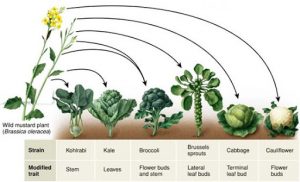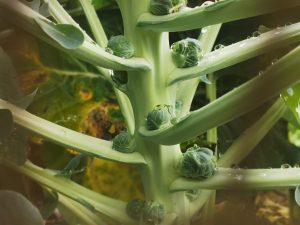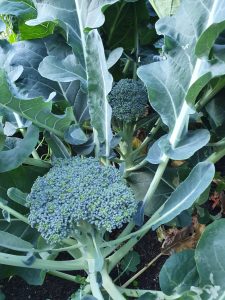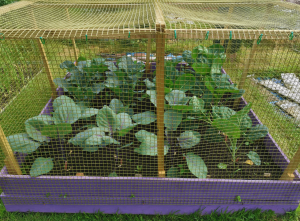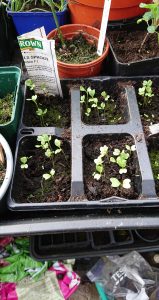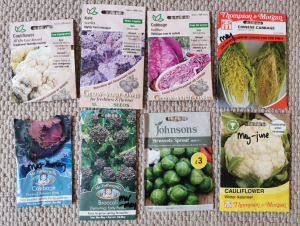
What Are Brassicas?
Brassicas include food such as cauliflower, broccoli, sprouts, turnip, swede, kohl rabi, cabbage, kale, and pak choi.
Turnip and swede were covered in the previous post, Root Crops – click here to read it.
Different brassicas are grown for different purposes, for example cauliflower and broccoli is the flower head, but before the flowers open. Pak choi and kale are grown for leaves which are picked individually. Sprouts are actually the sideways leaf buds which are picked before they open.
You can eat the leaves of all brassicas in stir-fry, or raw. Pick them when they are small (10-15cm). Some leaves can grow to be HUGE – 30cm long!
Which Ones to Grow?
Grow what you and your family like. Last year on the allotment I had sprouts, cauliflower, broccoli and cabbage. My Momma likes pak choi in stir fries. No one in the family or household likes kale so we never grow it.
There are colour variants that you can try growing too. Red cabbage, red or purple kale, red sprouts, purple cauliflower, purple brocoli, and you can even get red frilly sprouts!
How Many to Grow?
This depends on what you like! I love sprouts so I grow about ten sprout plants to get hundreds of the little green balls of joy. Generally speaking, a cabbage, cauliflower or broccoli plant will only produce one main head – so one plant gives one cabbage. Sprouts can produce 30-40 sprouts per plant, and kale will regrow leaves as you pick them off.
Where to Grow Brassicas
Brassicas will need protection from birds. Pigeons LOVE to eat them! On my allotment last year, I made a brassica cage and this is something we have also done at our Selly Oak Green Gym site. For protection, polytunnels work well but you need to be able to ventilate them to let hot air out and fresh air in. I used my favourite mesh from Wilkos as it is strong enough to withstand the weight of birds landing on it without them getting tangled up. It also doesn’t rip or tear. You can use pea netting (readily available from Poundland or Wilkos) but this is a pain to reuse as it tangles and rips easily, and birds also get tangled in it.
These types of crops also need protecting from butterflies – yes, the large white and small white both lay their eggs on brassicas (they are known as Cabbage White Butterflies), and the caterpillars will eat the leaves and flower buds, with not very much remaining. Birds are one of the best pest controllers as they catch caterpillars to feed to their young. Slug pellets will do nothing.
This is the brassica cage from my allotment last year:
Brassicas do not need pollinating so can be grown under shelter ie a greenhouse or polytunnel. The plants get quite big and bushy so need a lot of room between and around them – 45cm in each direction!
Growing Brassicas
This article was written pre-lockdown, but brassicas can be planted at all times of the year. These plants will over winter with some protection (fleece) for an early crop next year. The best time to start seeds is in late March under cover, for planting out in May and June. Sprouts taste better after they’ve been frosted and are a true winter harvest.
You can grow these plants from seed starting now. Put some compost in a pot and one or two seeds per pot, then put them somewhere to germinate. A windowsill will work fine, as will a greenhouse. You can put plastic bags (bread bag, sandwich bag, freezer bag) over the pots to act as a mini greenhouse. Keep the soil damp but not sodden.
You can also cheat a bit and buy plug plants if you can find any during your grocery shopping at the moment – this is my preferred method usually, but as I can’t find any plants I will be starting mine from seed this year.
Cauliflower stays white because light is blocked out. To do this, as the cauliflower head is growing, you need to gently fold the leaves over into the middle to protect it from sunlight.
Remove the leaves from sprout plants from the bottom of the stem upwards, so that the sprouts have room to swell. Try and cut or break the leaves as close to the stem as possible.
Plant Spacing
Space them out with at least 35-40cm between seed/plant. The leaves get BIG. My brassica bed last year was 6ft x 6ft and had 25 plants in it, which was far too many. I should’ve had a maximum of 16 plants in a 4×4 grid.
As sprouts get taller they may need support in the form of canes. Do not break the top off the sprout plant as they need this to keep developing the side shoots (which become sprouts). At the end of the season when you’ve picked all the sprouts, you can then use this top bit like a cabbage – two crops for one plant!
Crop Rotation
Brassicas love nitrogen, so plant them somewhere that had peas or beans before.
Companion Planting
You can grow flowers in with your brassicas, such as nasturtium and French marigolds. You can also intercrop with salad stuff like radish, lettuce, spinach and chard but these will get shaded out as the brassica leaves grow.
If your brassica starts to produce flowers, this means that it has bolted and will no longer put energy into developing the veg you want. Cauliflower and broccoli are the flowers before they fully open, and when these start to open and you see yellow bits, they need picking and eating.
Quantities
Depends how much room you have and how many sprouts you have with every meal! As these plants take up a lot of room, you may only want to try one of each plant. Maybe set up a plug plant or seed swap with neighbours if you have too many? Leave them on the end of your driveway/front step with a sign saying people can take them – and signpost them to this post so they know what to do!
Harvesting
For kale, pak choi, and using leaves for stir fry, simply cut or twist & break off the leaves you want. A sharp knife gives a cleaner cut but ripping also works.
For sprouts, twist and pull away to snap individual sprouts off the stem.
For cabbage, cauliflower, and broccoli, a sharp knife or maybe even a small saw (I am not joking!) will be needed to cut through the stem. Some of our cabbages last year had a stem diameter of 3 inches.
Hints and Tips
Beans and peas are a great food to grow with children as the seeds are big enough to see and handle, which also makes it easy to get one in each hole.
If you have any questions, Laura is happy to answer them via email, Facebook or Twitter
- Email: Laura.Hamilton@TCV.org.uk
- Facebook: Health For Life in the Community
- Twitter: TCV_Birmingham
Remember to share your pictures with us on Facebook and Twitter too!
